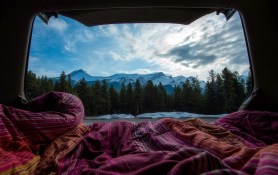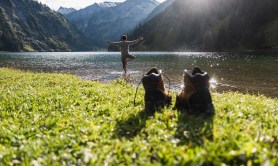

If you’re looking for ways to stretch your vacation time and your budget this summer, the “slow travel” trend might be just the change of pace you need. Slowing down your travel can involve taking public transit or trains instead of driving or flying, walking long distances instead of taking cabs, and seeing one place more fully instead of zipping across a country or a continent in a week or two. It’s generally better for the environment, and it can save you money, too. Here are a few ways to try out slow travel this summer by spending less time flying and more time exploring on foot and by train.
Videos by Outdoors
Rent an apartment instead of staying in a hotel
Airbnbs and similar vacation rentals aren’t always the cheapest way to travel anymore, but they do offer you a sort of location flexibility a lot of hotels can’t compete with. If you book far enough in advance, you might be able to find a great deal on a house or apartment rental where you can cook your own meals and stay in a part of town where people actually live, as opposed to a super-touristy hotel hotspot where everything caters to short-term visitors. If you stay in a real residential neighborhood, you might get a better sense of the place you’re visiting, and find yourself slipping into a totally new and refreshing morning walk routine that gives you perspective on your life back home.
Drive or take a train or ferry instead of flying

One of the principal tenets of slow travel is that it is, well, slow. Or, at least, slower than flying. It’s far more sustainable to travel by train, bus, or car than it is to fly, and you’ll get to see a lot more scenery along the way, too. In North America, train options can be limited, though Amtrak occasionally offers two-for-one deals for sleeper car accommodations on long-haul routes.
In Europe, you can buy a Eurail Pass for unlimited international train travel (with some exceptions and extra fees). Some countries also have their own versions of these passes, like the Swiss Travel Pass, which gets you access to virtually all forms of public transit throughout Switzerland, and the Deutschland-Ticket, which costs just 49 euros for unlimited use of local and regional public transit throughout Germany.
And don’t forget about ferry travel. There are islands all around North America connected to the mainland by ferries, and in Europe, you can find overnight ferries between England and Ireland; Spain and Italy; Denmark and the Faroe Islands, and more. You can find ferry routes on Google Maps by zooming out on and looking for dotted lines that extend into the ocean from coastal cities.
Stay put in fewer places, for longer
Instead of trying to see a whole continent in the span of a week or a month, pick one or two cities and hunker down into a good home base. If you have limited vacation time and always want to maximize the number of places you see, this can seem counter-intuitive. But try to think of it as traveling deeper. Instead of hitting the highlights—the single most popular trail, the tallest waterfall, the biggest rock formation—and moving on, you’ll get to see the places that short-term visitors don’t usually take the time to go to. You’ll have more time to engage with the history and culture of a place. You might also save money on travel and lodging, as vacation rentals are often discounted when you stay for 7 or more nights. This could afford you some budget flexibility to take a day trip from your home base without having to carry all your luggage with you—so you can travel a little lighter, freer, and more like a local.
Go backpacking—the wilderness kind

Instead of budget hostel-ing your way through Europe, try backpacking through the woods instead. You’ll see a completely different side of the landscape than you would zipping through in a car, and you’ll get to enjoy all the mental health benefits of hiking, too. If you’ve never tried backpacking before, you can look for outdoor clubs, gear shops, and brands in your region that host trips for a wide range of experience levels. TourRadar is a great way to find package deals on hut-to-hut hiking trips around the world and guided wilderness experiences where you won’t even have to set up your own tent. The Fjällräven Classic is a budget- and beginner-friendly, multi-day camping trip hosted in a variety of countries including the U.S., Germany, Sweden, Denmark, and Korea.
Use public transportation instead of renting a car
If you’re going somewhere with a good public transportation system, ditch the rental car and commit to getting around on foot or by bus, train, and tram—or even by gondola, in some mountainous towns like Telluride, Colorado, Medellín, Colombia, and Zermatt, Switzerland.
If you don’t normally use public transportation in your everyday life, this can feel challenging at first. But think of it as part of the adventure, and as a way to see parts of a town or city that you otherwise might miss. You might spot something from the window that you want to check out later, which you never would have discovered if you were driving and paying attention to traffic. Some cities also have visitor-friendly public transportation passes that allow you to travel an unlimited amount for a set fee, so you can hop on and off transit as you please without worrying about the prices.









